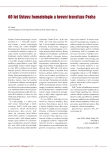Emergency situations in hematology
Authors:
M. Marková
Authors‘ workplace:
Ústav hematologie a krevní transfuze Praha, ředitel prof. MUDr. Marek Trněný, CSc.
Published in:
Vnitř Lék 2012; 58(Suppl 2): 61-64
Category:
Overview
Both the development of new therapeutic strategies and intensification of the treatment of haematologic patients lead to increasing number of emergencies that must be immediately resolved. Some of these complications may be specific for this type of patients and they frequently occur at the time diagnosis and initial therapy. Although this type of treatment is usually provided in hematologic centers, the patients often need primary care immediately when complication appears. The paper should shortly outline the specific problems of these cases.
Key words:
tumor lysis syndrome – hyperleukocytic syndrome – hyperviscosity syndrome – hypercalcemia – SIADH – vena cava superior syndrome – neutropenic fever
Sources
1. Pession A, Masetti R, Gaidano G et al. Risk evaluation, prophylaxis, and treatment of tumor lysis syndrome: consensus of an Italian expert panel. Adv Ther 2011; 28 : 684–697.
2. Coiffier B, Altman A, Pui CH et al. Guidelines for the management of pediatric and adult tumor lysis syndrome: an evidence-based review. J Clin Oncol 2008; 26 : 2767–2778.
3. Howard SC, Jones DP, Pui CH. The tumor lysis syndrome. N Engl J Med 2011; 364 : 1844–1854.
4. Clines GA. Mechanisms and treatment of hypercalcemia of malignancy. Curr Opin Endocrinol Diabetes Obes 2011; 18 : 339–346.
5. Sargent JT, Smith OP. Haematological emergencies managing hypercalcaemia in adults and children with haematological disorders. Br J Haematol 2010; 149 : 465–477.
6. Rudnay M, Hrabčáková P, Lazúrová I. Hyponatriémia při syndróme neprimeranej sekrécie vazopresinu (SIADH) – možnosti léčby. Vnitř Lék 2012; 58 : 52–55.
7. Esposito P, Piotti G, Bianzina S et al. The syndrome of inappropriate antidiuresis: pathophysiology, clinical management and new therapeutic options. Nephron Clin Pract 2011; 119: c62–c73.
8. Porcu P, Cripe LD, Ng EW et al. Hyperleukocytic leukemias and leukostasis: a review of pathophysiology, clinical presentation and management. Leuk Lymphoma 2000; 39 : 1–18.
9. Stone MJ, Bogen SA. Evidence-based focused review of management of hyperviscosity syndrome. Blood 2012; 119 : 2205–2208.
10. Schraufnagel DE, Hill R, Leech JA et al. Superior vena caval obstruction. Is it a medical emergency? Am J Med 1981; 70 : 1169–1174.
11. Ahmann FR. A reassessment of the clinical implications of the superior vena caval syndrome. J Clin Oncol 1984; 2 : 961–969.
12. Ribas ES, Schiff D. Spinal cord compression. Curr Treat Options Neurol 2012; 14 : 391–401.
13. Prasad D, Schiff D. Malignant spinal-cord compression. Lancet Oncol 2005; 6 : 15–24.
14. Lyman GH, Kuderer NM, Crawford J et al. Predicting individual risk of neutropenic complications in patients receiving cancer chemotherapy. Cancer 2011; 117 : 1917–1927.
15. Hughes WT, Armstrong D, Bodey GP et al. 2002 guidelines for the use of antimicrobial agents in neutropenic patients with cancer. Clin Infect Dis 2002; 34 : 730–751.
16. Franchini M, Mannucci PM. Inhibitors of propagation of coagulation (factors VIII, IX and XI): a review of current therapeutic practice. Br J Clin Pharmacol 2011; 72 : 553–562.
17. George JN. Clinical practice. Thrombotic thrombocytopenic purpura. N Engl J Med 2006; 354 : 1927–1935.
Labels
Diabetology Endocrinology Internal medicineArticle was published in
Internal Medicine

2012 Issue Suppl 2
Most read in this issue
- Immunohaematology – the history, current knowledge and the role of The Institute of Haematology and Blood Transfusion in Prague
- Emergency situations in hematology
- Hemapheresis – the efficient therapeutic technique in clinical practice
- Chronic myeloid leukaemia – a crucial change to the patient prognosis after an introduction of tyrosine kinase inhibitors
